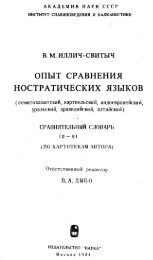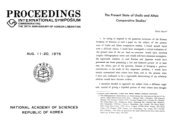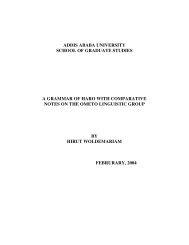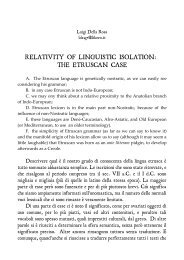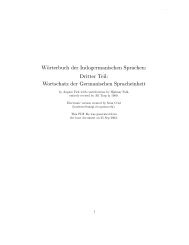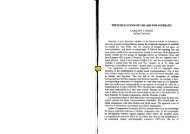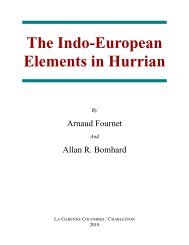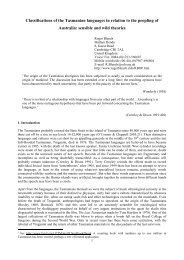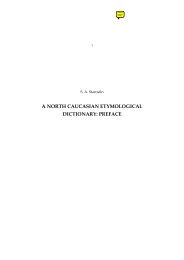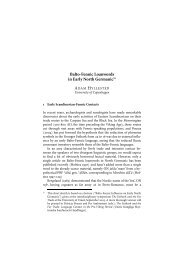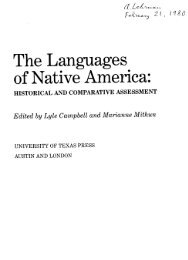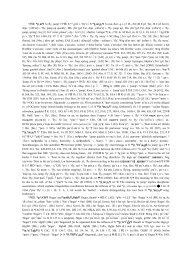You also want an ePaper? Increase the reach of your titles
YUMPU automatically turns print PDFs into web optimized ePapers that Google loves.
Witzel, M. 2005c. "Slaying the Dragon in Eurasia:' [Longer version of the present paper,<br />
including aspects of the summer solstices].2 nd Indology conference at Nanhua University,<br />
Dalin, Chiyi, Taiwan,Oct. 2005.<br />
Witzel, M. 2006. "Creation myths:' Proceedings of the Pre-Symposium of RHIN and 7th ESCA<br />
Harvard-Kyoto Round Table, Ed. by T. Osada, 284-318. Kyoto: Research Institute for<br />
Humanity and Nature (RHIN).<br />
Witzel,M. (forthcoming). Origins and Dispersal of our First Mythologies. [Book in preparation]<br />
(working title)<br />
Yang,L., D. An, with J. Turner. 2005. Handbook of Chinese Mythology. Handbooks of World<br />
Mythology.Santa Barbara, Calif.:ABC Clio.<br />
<strong>Trombetti</strong><br />
The forefather of Indo- Pacific<br />
Jonathan Morris<br />
Sao Paulo, Brazil<br />
The work of the Italian linguists Alfredo <strong>Trombetti</strong> and Riccardo Gatti<br />
on their hypothesis of genetic relationship between the languages of the<br />
Andaman Islands, Papua New Guinea, Australia, Tasmania, and the<br />
Dravidian languages is discussed in detail. It is shown that <strong>Trombetti</strong><br />
and Gatti had formulated a coherent precursor of the "Indo- Pacific"<br />
hypothesis (Greenberg 1971) by 1906.<br />
I would like to begin by expressing afew words of thanks to Hal Flemingfor his generous<br />
support. In our current era of academic hyperspecialisation, creating and sustaining an<br />
open forum such as Mother Tongue over two decades is a rare achievement in itself,<br />
but is made even rarer by Hal's enthusiasm for discussing and developing ideas, my<br />
work being a case in point, since he was the one who insisted on my developing a<br />
casual observation into an article on <strong>Trombetti</strong>'s views on Indo-Pacific. Since only haif-<br />
a-dozen of the SOO-odd pages of his major work Glottologia (<strong>Trombetti</strong> 1923) deal<br />
with the subject (see Morris 2006), this is no easy task. These few pages nevertheless<br />
contain many references to another earlier work by Riccardo Gatti (1906-1909) with<br />
two introductory essays by <strong>Trombetti</strong> himself, showing that the latter figure was closely<br />
involved with the project. Gatti merely trawled through the existing vocabularies of the<br />
day (E.M. Curr for Australia, Ray for British New Guinea, Schmidt for German New<br />
Guinea and Portman for the Andaman Islands) looking for cognates, but found so<br />
many that only a small fraction can be presented here. I have thus chosen to concentrate<br />
on his Andamanese data, both on grounds of relative completeness and because it<br />
demonstrates that <strong>Trombetti</strong>'s belief in an intimate genetic relationship between the<br />
languages of the Andaman Islands, Papua New Guinea and Australia/Tasmania and<br />
the Dravidian languages was solidly data driven. <strong>Trombetti</strong>'s comments also show that<br />
he had formulated a coherent precursor of the "Indo- Pacific" hypothesis by 1906.<br />
In my review of <strong>Trombetti</strong> (Morris 2006), I attempted to dispel the popular caricature<br />
that he had fallen into disgrace by espousing a single origin of language, as well as to<br />
introduce a more nuanced portrayal of him as an outstandingly gifted natural linguist<br />
who rose from the most modest circumstances to hold a chair at the university of<br />
Bologna, receiving official recognition until his death in 1929.
Jonathan Morris<br />
I also sought to show that his point of departure was a rigorous classical training<br />
in Indo-European and Semitic linguistics and a conviction that conclusions had to<br />
arise from his linguistic data. This put him very much at odds with the largely German<br />
linguists of the late 19th century such as Muller, who in <strong>Trombetti</strong>s view had ac-<br />
quired an ideological baggage that caused them to subordinate i~eas ~bou: language<br />
to notions of race based mainly on physical anthropology. Such VIews, inspired by the<br />
evolutionary ideas of Ernst Haeckel, held that humanity had been divided into irrec-<br />
oncilable racial categories and hence that language, which arose at a later stage, must<br />
necessarily be polygenetic in origin. <strong>Trombetti</strong> saw himself as crusading for a return to<br />
the inclusive view of humanity of the Enlightenment, albeit with a difference.<br />
In <strong>Trombetti</strong>'s view, figures such as Franz Bopp had perceived that families such as<br />
Indo-European could have genetic links to other language families (notably the Poly-<br />
nesian family) but lacked the theory to elucidate the nature of these links. In the same<br />
way as Greenberg built up his theory of Eurasiatic by showing that Indo-European,<br />
Eskimo, Uralic, etc. shared a wealth of morphological elements, <strong>Trombetti</strong> believed<br />
that a similar theory was possible at an even greater level of generality, and that by<br />
categorising these, he would be able to explain many features e.g., ofIndo-European,<br />
which had appeared baffling and arbitrary to Bopp. <strong>Trombetti</strong> suggested, for example,<br />
that what appeared (and still appear to us) to be indivisible elements, e.g., pronouns<br />
such as mi/ni/ki/ik actually had a fine structure in which the vowel was the semantic<br />
element and the consonant more of an auxiliary structuring element, or that verbal<br />
roots could actually be fusions of two separate verbal roots, CV 1+ C/V 2)'<br />
Since, unlike his contemporary, Saussure, <strong>Trombetti</strong> regarded languages as inher-<br />
ently conservative, he believed that surviving languages could still provide insights<br />
into the origins oflanguage itself, although he considered that the process which gen-<br />
erated a fully functional and sophisticated agglutinative language had long since been<br />
completed.<br />
<strong>Trombetti</strong> was writing without the benefit of our knowledge of hominid evolu-<br />
tion or modern genetics, at a time when "primitive" peoples such as the Khoisan<br />
were widely regarded as a missing link between apes and humans. His view that they<br />
were highly intelligent humans adapted to a hostile environment was thus strik-<br />
ingly modern. At the same time, he did not share Rousseau's romanticised view of<br />
the "noble savage". If the Andamanese tribes had an extremely primitive lithic tech-<br />
nology, it was, in <strong>Trombetti</strong>s view, because their skils in the area had generated, albeit<br />
by occupying the most remote and marginal habitats that were not subject to the<br />
pressures of civilisation, they had succeeded in maintaining their hunter-gatherer<br />
lifestyle until modern times. At the same time, the fact that his data showed the longrange<br />
conservation of morphological elements between "primitive" languages (e.g.,<br />
numerals, pronouns, prefixes and suffixes) led him to equate cultural conservatism<br />
with linguistic conservatism.<br />
<strong>Trombetti</strong>: The forefather of Indo-Pacific 289<br />
Furthermore, <strong>Trombetti</strong> located the cradle of language in India, on the grounds<br />
that it was the area containing the largest number of major language phyla and had an<br />
apparent relative abundance of fossil evidence. From an Oceanic perspective, India<br />
was not such a bad guess, since, on the one hand, the modern "Out-of-Africa" initial<br />
rapid "beach-hopping" model actually does posit India as a secondary origin for such<br />
languages, and on the other, an "un rooted tree" approach to examining long-range<br />
linguistic relationships between Africa and Oceania is arguably more objective than<br />
one rooted in Africa.<br />
Weaving these two strands of thought together, it should be clear that it was en-<br />
tirely natural for <strong>Trombetti</strong> both to expect the languages of a series of stone age peoples<br />
such as the inhabitants of the Andaman Islands, Papua New Guinea and Australia to<br />
preserve traces of their original unity in a South Asian homeland, regardless of how<br />
remote they had become from each other in geographical terms.<br />
What is far more remarkable is that <strong>Trombetti</strong> appears to have changed his views<br />
radically some time between late 1905 and mid -1906, where he realised that his<br />
Andamanese-Papuan-Australian ' family was distantly related to but discrete from<br />
Austro- Asiatic.<br />
This is a significant change from the position of Schnorr von Carolsfeld (1890),<br />
who had proposed that the languages of Oceania belonged to a superfamily. In his<br />
publication dated July 1905, <strong>Trombetti</strong> appears to accept the former linguist's claim at<br />
face value:<br />
Indeed, the reciprocal affinity between all the languages of Oceania was affirmed<br />
and almost sufficiently demonstrated by Schnorr von Carolsfeld; (it is a pity that the<br />
author has not yet given us his promised work on the languages of Tasmania). The<br />
Malayo-Polynesian group was certainly connected with the Mon- Khmer languages,<br />
while the languages of our Andamanese-Papuan-Australian are particularly close<br />
to the Kolh languages, which in turn were connected to the Men-Khmer group of<br />
E. Kuhn and others. If we then also remember the relations with the languages of<br />
Africa, the resulting image is one of a cycle or network. [<strong>Trombetti</strong> 1905: 16]<br />
His preface to Gatti published a year later adopts a very different tone.<br />
As [Gatti] advises, the work is independent of Schnorr von Carolsfeld, despite<br />
the merits of the latter, who proposed to show the connection of all the Oceanic<br />
languages and thus extended his comparisons to Malayo-Polynesian. The need to<br />
distinguish two groups is nevertheless evident for lexical and above all grammatical<br />
reasons. I shall now indicate what seem to be the principal characteristics of the<br />
Andamanese- Papuan -Australian group.<br />
1. <strong>Trombetti</strong> alwaysassumed that Tasmanian was subsumed into Australian.
290 Jonathan Morris<br />
1. The phonetic system is simple and without spirant sounds. The Papuan spi-<br />
rants are of secondary origin.<br />
2. Words are formed through prefixes and suffixes. Many adjectives are formed<br />
by duplication, those with a negative sense often derive from corresponding<br />
words with a positive sense.<br />
3. In several languages of this group, there is grammatical gender. In Andamanese,<br />
we may note a kind of classification through prefixes (of which traces remain<br />
in Papuan and Australian) in names of parts of the body and kinship.<br />
4. The declension takes the form of suffixes or postpositions.<br />
5. An ergative case in use - i.e. of the operant subject. The verb that refers to the<br />
same often seems to be conceived as a passive. An extremely common ergative<br />
suffix is -da, -du, which is often omitted for personal pronouns.<br />
6. The construction is inverse B-A.<br />
7. The pronoun is declined like the noun. The dual and plural are formed in different<br />
ways from that observed in Malayo-Polynesian. In the first person of the dual<br />
and plural, there is often a distinction between inclusive and exclusiveforms.<br />
8. Possessive pronouns are formed in a different way from Malayo-Polynesian.<br />
Generally, they result from compounds of the personal pronouns followed by<br />
a particle (contrary to Melanesian and Polynesian languages).<br />
9. Conjugation is complex. A final form may be distinguished that is a kind of<br />
supine like Latin ire dormitum.<br />
10. Numbers are low, often merely binary.<br />
In almost all these points, the characteristics of Malayo-Polynesian are opposite<br />
or different.<br />
[Gatti 1906-1909, Vol. 1, Introduction viii-ix]<br />
In Glottologia (<strong>Trombetti</strong> 1923), he merely embellished the above 10 points, suggesting<br />
that he had done little additional work on Andamanese since the work with Gatti? was<br />
completed before 1910. 3 While even in his late works, <strong>Trombetti</strong> could be irritatingly<br />
vague," the fact nevertheless remains that between 1905 and 1906, he shifted from the<br />
2. Apart from the work on Andamanese-Papuan-Australian, published in three volumes in<br />
1906, 1908 and 1909, he appears to have published a small pamphlet on gender in Indo-European<br />
in 1912. There is also a small vocabulary of the local dialect of the town of Iesi (near<br />
Ancona) in 1920 by one Riccardo Gatti, but it is not clear whether the author is the same.<br />
3. I have found referencesto an article which <strong>Trombetti</strong> wrote in 1921 on Papuan-African connections<br />
(Festschrift Meinhoj) and another in 1926 on Tasmanian (Acts of the 22nd International<br />
Conference of Americanists), but have not succeeded in locating the original papers.<br />
4. E.g., with his bad (by modern standards) habit of describing languages as "intermediate"<br />
between language families, such as Basque as "intermediate" between Kartvelian and<br />
Hamito-Semitic.<br />
<strong>Trombetti</strong>: The forefather ofIndo-Pacific 291<br />
jumble oflanguages proposed by Schnorr von Carolsfeld to a clearly defined language<br />
family which subsumed Indo- Pacific.<br />
His extension of this family to include Dravidian appears to have taken place by<br />
the time he had published his study of pronouns (<strong>Trombetti</strong> 1908: 1 I pronomi per-<br />
sonali), largely as a result of his work on pronouns. The Narinyerri? language in par-<br />
ticular intrigued him:<br />
The general and extremely close agreement between the Dravidian and Australian<br />
forms appears from the pronouns ...<br />
Tamil: engal- (we, exclusive) = Aus: ngali, ngadli; Tulu: yenkulu (gentiv e), yenkule<br />
(id.); Aus: ngule, ngadli; Tulu: yenkulenu; Aus: ngulina<br />
Drav: nan (I), nam (we) = Narrinyerri: nan (me); nam we = Dabu: (Papua) nana (I);<br />
Drav: nam (we) = Narrinyerri: nam (we); Drav: num (we) = Narrinyerri:<br />
nom (we)<br />
Given that Narinyerri also bore similarities to Andamanese:<br />
Narrinyerri: ngu-rra, ngu-rre (you sing.) = General Andamanese: ngo-lla, ngu-le [also<br />
found in Aus 88, 205 ngooro, 84 ngurra, ngurru, 85 nooroo, 207E ngoro]<br />
Narrinyerri: ki-tje (he) = ki-te (Kede), li-le (Juwoi)<br />
Narrinyerri: mei-ke, mey-a-k (North) (who?, what?) = me-ce (who?), mi-a-k,<br />
me-a-k (what?)<br />
Narrinyerri: ninka-ienk, ninga-u (South) (two) = ninaga (Onge)<br />
While my primary aim is an accurate portrayal of <strong>Trombetti</strong>'s ideas and data rather<br />
than an assessment of their merits, we may note in passing that the revision of his<br />
hypothesis to include Dravidian has the anomaly of showing better matches with Aus-<br />
tralian than with Andamanese or Papuan. See Appendix II.<br />
Furthermore, <strong>Trombetti</strong> had noted that Dravidian showed far greater affinities to<br />
Hamito-Semitic (including a link to Nilotic through Elamite) than to Bantu-Sudanese,"<br />
while the converse was true of Munda -Polynesian. At the same time, in his analysis of<br />
prefixes, <strong>Trombetti</strong> believed that Bantu and Andamanese had cognate prefixes, Bantu:<br />
aka-mwa (mouth) and Bea: aka-bang-da, Bale: aka-boang, etc. (mouth), where aka<br />
was originally a prefix indicating body parts, and Bantu: ele-(one of a pairi/Bea, Bale<br />
I-dal, Kede: er-tol (eye); Kede: ir-pol (two).<br />
Viewed from a modern perspective, I wonder whether <strong>Trombetti</strong>'s link to Dra-<br />
vidian is not demonstrating something else, i.e. evidence of a much later migration<br />
from India to Australia during the Mesolithic/Neolithic and possibly associated<br />
5. Modern Ngarindjerri - located on the lower Murray river and the Fleurieu peninsula in<br />
South Australia.<br />
6. I use the term Bantu-Sudanese with <strong>Trombetti</strong>'smeaning. It is clear from his work that the<br />
term is equivalent to the modern "Niger-Congo':SeeMorris (2006: 92) for discussion.
! Jonathan Morris<br />
with flooding of ancestral habitats at the end of the Ice Age, as is suggested by recent<br />
genetic work (Redd et al. 2002). If so, then the implications of Trornbetti's work<br />
are that the South Indian populations which migrated to Australia were Dravidian<br />
speakers, even if he was probably wrong to include this family in his Andamanese-<br />
Papuan -Australian phylum.<br />
1. Andamanese<br />
In Glottologia, <strong>Trombetti</strong> states his belief that languages related to those of the<br />
Andaman Islands had once been spoken on the mainland of South East Asia (from<br />
where the Andaman Islands themselves had originally been populated), and along<br />
the Indonesian archipelago all the way to New Guinea, being displaced by Malayo-<br />
Polynesian speakers at a much later date. He thus believed that aboriginal populations<br />
of Malaysia such as the Semang were related to the Andamanese, but that only a few<br />
traces of the latter's original language remained as a substrate in an otherwise Mon-<br />
Khmer language. He nevertheless cited some examples of these drawn from Skeat and<br />
Blagden (e.g., Semang Snake je-kob, i-kob, see Snake-2 below).<br />
Returning to Gatti, the following is a list of all Andamanese words cited in his<br />
work, with respective cognates in Australian and Papuan. Gatti selected a series of<br />
around 100 lexical items, giving a set of polymorphisms for each item. His most<br />
copious raw material was the Australian material drawn from Curro If, say, Curr<br />
described 10 Australian word families for snake, and the fifth word family had an<br />
Andamanese cognate, then this will be described below as Snake-5. It goes without<br />
saying that <strong>Trombetti</strong> did not have a comprehensive set of linguistic data to work<br />
with. Indeed, Curr himself presents a great deal of information on languages in S/SE<br />
Australia and hardly anything on the languages of Arnhem Land, which is evidently<br />
a serious shortcoming of his work.<br />
At the same time, Itake issue with the only modern citation of Gatti's work that<br />
I have found (Usher 2002: 67).7 In my view, Usher's comments are invalid for three<br />
reasons. Firstly, it should be clear from the above discussion that <strong>Trombetti</strong> was<br />
perfectly well aware of the sharp morphological distinction between Andamanes e -<br />
Papuan-Australian, as well as of the territorial distinction between what he called<br />
7. "Both <strong>Trombetti</strong> and Gatti believed Tasmanian to be a member of a vast family,including<br />
the languages of New Guinea and Australia, along with Andamanese, and proposed many<br />
hundreds of etymologies of widely varying credibility, to support their contention. However,<br />
very little data from Indo-PacificNew Guinea was availableto them, and their "Papuan" data is<br />
mostly Austronesian:'<br />
<strong>Trombetti</strong>: The forefather ofIndo-Pacific 293<br />
Melanesian languages spoken on the coast of New Guinea and the Papuan languages<br />
spoken in the interior (<strong>Trombetti</strong> 1923: 68). Secondly, I note that <strong>Trombetti</strong>'s lexical<br />
items drawn from Ray's list of 22 Papuan languages and Schmidt's list of a further 15<br />
languages substantially agree with the word lists/reconstructions given by Foley for the<br />
Lower Sepik, Gorokan, Kainatu and Proto-Highlands families (Foley 1986: 215-16,<br />
246-8,253-4,257-8), which presumably pass the smell test as genuine Papuan data.<br />
Thirdly, despite little overlap between lexical items, there are some excellent matches<br />
between <strong>Trombetti</strong>'s data and Whitehouse and Usher's own Kusunda cognates, with<br />
the data of the former extending the analysis of the latter to Australian." It is true that<br />
Gatti includes a list of Malayo-Polynesian cognates in Vol. II, but it is abundantly clear<br />
from his and <strong>Trombetti</strong>s work that they regarded this relationship as a distant one.<br />
2. Andamanese- Papuan- Australian Cognates<br />
Father-5: And Bale mama, Bea mam-ola (father-in-law); Aus 10/190/213 mama,<br />
9/12/25/27/28 mamma, 23/31 mam, 34/40 mumma, 199, mamoo, 201<br />
maamo, 202/203 mamai, 204 maame, 206/207A, 207E maam, 209B<br />
maama, 207B/207F1207G/207H/208E mami, 21/22 mama -n, 16/17/19/40<br />
mamma-n, 18/20/24/26/30 mammo-n, 208G maami-n, 209D mamo-n,<br />
29 mama-tha; Bng Koiari/Eikiri/Koita marne, Kupela mama; Gng Kai<br />
mama, Bongu mem<br />
Mother 1: And Bea chana-da. Aus 25/32/33 kun, 201 konoo, 190 gunnee, gunnie,<br />
koo-nee,koonea,goonee,gunnee,goonee,koonee,gooni<br />
Mother-2: And Kol aute-tu-nen; Aus 159 too<br />
Mother-3: And Kede merni, Chariar ta-rnemi (cfMilk-2 and Father-5)<br />
Mother-8: And [uwoi nau -lekile [see wife][NB this suffix very common in Iuwoi],<br />
Aus 188 naae, 55 noa, 46 nooa (wife); Bng Kupela, Meroka neia,<br />
Motumotu nou; Gng Valmau nue, Hatzfeldhafen nana, Wenke nyan<br />
Woman-2: And Bale ab-chau-pal: Aus 102 kooberrro (negress),<br />
Woman-3: And Bea ab-chau-da [see mother]; Aus 162 keen,<br />
Woman-5: And Kede eb-buku, 36 lao-buku: Aus 43 boku, 45 bookoo; Bng<br />
Kauralaig i-pikai;<br />
8. 1. Kusunda Father mam and Father-5 above;2. Kusunda Short potoo, Gatti Small Aus 16<br />
poton, 19 b~ttene, 25 botine; Gng 1 pitine; 3. Kusunda Daylight jina ikya, Gatti Sun Aus 74<br />
ooko, And Onge 9 eke;4. Kusunda Breast ambu = Gatti Breast Aus 69A ama, 72 amma, 145<br />
ammooa, 155/164/167amoo, 17l ema, 190amoo, 47/48/74/76/79/107/172/173umma, 77 ummi,<br />
170um~oo; ~.~usunda Egg gwa/goa r-oss.link to Gatti EGG Aus 107kookurry, kokarri; Bng<br />
Kauralaig, Saibai kakur, Gng Poom kokoile-madeine:6. Kusunda Dog agai poss. link to Gatti<br />
Dog Aus 113kia, 115kaya, 110kai-a, 116gyai;Gng Hatzfeldhafenke,
14 Jonathan Morris<br />
Woman-6: And Bea ab-pail-da, Bale ab-pail [see Wife-3]; Aus 207E pulle-pulle,<br />
197 balla-n<br />
Woman-7: And puchikwar ab-ob-da, [uwoi a-u-Iekile Kol e-op-che [see Wife-4];<br />
Aus 164 abo-n (mother), 170 oopar (wife);<br />
Man-2: And Puchikwar kauro-da; Aus 185 koari, 186 korry, 187 korri, 188 kurri,<br />
206/207G/208H koole, 207H kooli, 208J koday; Bng Saibai gara (boy),<br />
Toaripi/Motumotu karu (man); Gng Valmau k61<br />
Man-3: And Bea ab-chabil (having wives); Aus 136 kabulla, 179 gibberra, 164 gibere<br />
Man-4: And Kede e-tairu, Chariar e-taru; Aus 60 thura, 61/62 tura<br />
Man-5: And Bea bula-da, Bale bula: Aus 1811190 boori; Bng Elema bira<br />
Man-8: And Bea ab-wara-da (bachelor); Aus 176 woori-n<br />
Child-I: And Bea aka-kadaka-da, Bale aka-koadoko. Puchikwar o-kadaka-da.<br />
[uwoi oko-kadaka. Kolo-kadaka-che; Aus 100 kuttukka<br />
Child-2: And Chariar chote: Aus 53 kidtha, 196 goodtha, 182 kootha-ra<br />
Child-3: And Kol a-t're-che, Bojigiab ab-tire, Kol e-tira, Onge e-tire: Aus tuli,<br />
186 talli, 210 tally-leet, 180 talli-waku (children)<br />
Brother-I: And Puchikwar ar-chulutu-da. [uwoi ra-chulutu Kol ake-chulutu: Aus<br />
28 koorda, 36 quertea<br />
Brother-2: And Bea ar-doati-da, Bale ar-doto; Aus 159 dutha, 167 dooda, 181<br />
daidi, theady, tiade 102 theti, 194 tatha, 205 date (younger brother), 103<br />
tita, 105 titi<br />
Sister-L: And Bea ar-doati-dar, ar-doti-t: Aus 205 date, 207P tati<br />
Sister-2: And Puchfkwar a-chuletu-da. ra-chuletu, a-chuletu-n: Aus 24 quaret<br />
chukan, 33 quarrutchook<br />
Old Man-I: AndPuchikwarab-kara-da; Aus 69A karoo, 50, 51 kurroo, 141 kyerra,<br />
52 kooroo, 155 kiara, 181 kure, 140 kaera<br />
Old Man-2: And Bea ab-bula-da, Bale ab-bula: Aus 97 boolgin-boola, 59 bool-ka,<br />
60/61/62 pool-ka<br />
Old Man-3: And Bea, Bale ab-chauraga-da [NB: the au represents a long oj; Aus<br />
162 goorki, girki-l<br />
Commander/Chief: And Bea ab-maiola: Aus 89 moolia, 101 moola<br />
God: And Bea puluga -da, Kede bilke, Chariar bilek -che, Puchikwar bilik -da, [uwoi<br />
bilak-, Kol bilak-che; Aus 89 pargi-gi<br />
Blood-3: And Bea tei-da, Kede te-yi, Chariar e-te, Bale te, Bojigiab te-wa,<br />
Puchikwar teura-da, [uwoi tewa-, Kol tewa-che, Gng? so; Aus 1631165<br />
dee, 163 du<br />
Stomach-2: And Puchikwar chuta-da, [uwoi chute, Kol chute-che: Aus 190 gida-u,<br />
77 koonto<br />
Stomach 3: And Bojigiab e-chulu; Aus 124 keela, 5 gooro<br />
Eye-I: And Bea i-dal-da, Bale i-dal, Kede er-tol; Aus 114 dily, 9/10 toola [NB<br />
50 languages]<br />
Eye-4: And Chariar er-ulu; Aus 92 ale<br />
Foot-8: And 9 muge, Bng Dabu mak; Aus 1 macka, 96/991130 mago, 100 mukko,<br />
174 moko;<br />
1<br />
<strong>Trombetti</strong>: The forefather ofIndo-Pacific 295<br />
Foot-14: And Bojigiab ong-ta: Aus 38/39 inga, 37 inka/inniga<br />
Bone-4: And Bea ta-da, Bale toa, Puchikwar tau-da, Iuwoi tau-, Kol tau-che, Kede<br />
e-tu-we, Chariar etoi-i: Gng Kai sie; Aus 140 to a, 159 deea, 169 dea<br />
Ear-4: And Bea il-poko-da, Bale id-poku, Puchikwar ir-bo-da, Iuwoi re-baukau,<br />
Kol er-boke-che, Kede er-bu, Chariar er-buah: Aus 37 i-bagi-ta, il-poki-ta,<br />
38 il-poca-rta, ill-pocke-rta, 39 il-pucki-ta; Bng Eikiri i-piko, Koiari i-fiko,<br />
Koita, Favele i-hiko, etc.<br />
Hair-6: And Bea pich-da, Bale pich-da, Puchikwar paich-da, Kol paich-che, Kede<br />
paitch, Chariar paitch; Aus 180 bookia, 214A pok-kan,<br />
Hand-2: And Bea on-kauro-da, Bale ong-kauro, Puchikwar ong-kaura-da, Iuwoi aun-<br />
kurau-, Kol on-kaure-che, Kede am-koro: Aus 1 queear-warra, 162 gillee<br />
Head-2: And Bale ot-chekta: Aus 66 kockerti<br />
Head-5: And Bea ot-cheta-da: Gng Bongu gate, Manikam kadi, Bogadjim kate;<br />
Aus 18119/20/30112311331142 katta, 2211411147 kutta, 24 kata, 16 cata, 31<br />
kaat, 122 kida, 123 kudda, 131 kutha, 132 katha, 144 kada, 158 kuddo, 61<br />
a-kartee.<br />
Head-6: And Kede erchu; Aus 152 ulkey<br />
Mouth-3: And Bea akan-tewi, Bale akan-tewi, Puchfkwar om-tewe, Iuwoi aukorn-<br />
tewi, Kol om-tewe: Aus 114 thowa, 1381140 towa, 129 dthowa<br />
Nose-I: And Bea chauronga-da: Bale chaurnga; Aus 207B karnook<br />
Nose-2: And Puchikwar kaute-da, Iuwoi kaute-, Kol kaute-che, Bojigiab mir-katto;<br />
Aus 117 kooda, 114 kootha<br />
Skin-I: And ot-kaupo, ot-kobau: Aus 161 kooba, 164 koba-ra, 166 kubari<br />
Tongue-3: And Bea aka-tegi-da, Bale aka-tegi, Puchfkwar o-teke-da, Iuwoi<br />
aukau-teke-, Kol au-teki-che, Onge aka-teku, Chariar aka-teku: Gng<br />
Augustafluf tega-l; Aus 207E thage<br />
Tongue-4: AndBeaaka-etal-da,Baleaka-atal,Puchikwaro-tatal-da,aukau-tatal-,Kol<br />
tatal-che; Aus 16 tall an, 19 dallan, 158 dalli, 174 talle (v, widespread); Tas<br />
Jorgensen tullana<br />
Teeth-4: And Bea tog-da, Bale tog-, Aus 53 tiga, 167 ding, 169 deang<br />
Teeth-ll: And Puchikwar pela-da: Aus 152 pirra<br />
Teeth-12: And Onge makue: Aus 8 meeku-rro<br />
Breast-I: And Bea karn-da, Bale koam, Bojigiab ir-kam-da; Aus 158 kammoo,<br />
178 ngania<br />
Breast-2: And Chariar ot-char; Aus 109 coyar, 207H koroo-m, 207G kor-m<br />
Fly-4: And Bea bumila-da, Bale bumula: Aus 183 boomal<br />
Fly-5: And Chariar pulimu, Aus 190 booreema, 197 borema-n<br />
Mosquilo-2: And Bea teil-da, Bale tel, Puchikwar tel-da, Iuwoi tel-, Kol tel-che,<br />
Kede teil, Chariar teil, Bojigiab teil, Aus 191 doo-ra<br />
Snake-2: And Puchikwar chupe-da, Iuwoi chupe-, Kol chupe-che<br />
Prawn-2: And Bea waka-da, Puchikwar waka-da, Iuwoi waka-, Kol wakai-che:<br />
Aus 76 wegi-ga<br />
Duck-I: And Bea kulala-da, Kede kulal-da, Puchikwar kulal-da, Iuwoi kulal-,<br />
Kol kulal-che, Aus 8 kooleyalli
,6 Jonathan Morris<br />
Light-I: And Bea ar-chal-da, Bale ar-chal, Puchikwar ar-chol-da, [uwoi<br />
ra-chol-, Kol tu-chol-de (sunshine); Aus 176 gilli, 140 garra, 163<br />
kirree, 205 karo<br />
Light-2: And Kede dio: Aus 175 dei, dooegi; Bng Mowat duo<br />
Earth/Land- 2: And Bea gara -da, Bale goarada: Aus 179 garra, 82 karra<br />
Earth/Land-4: And Onge tutano: Aus 83 tuni, 181 toon, 181 towon/thoun/down/<br />
thone<br />
Earth/Land-5: And Iuwoi pakar-, Kol peakar-che; Aus 16 bugiara; 24 booga<br />
Earth/Land-7: And Puchikwar per-da, Aus 115 pMrii, 188 parri, 106 pulo, 113<br />
boora, 186 bur-ray, 187 burrai, 169 burri<br />
Fire-2: And Bea chapa-da, Bale choapo; Aus 193 kanbi, 196 gunbey<br />
Fire-3: And Onge tuke: Aus 7 toko<br />
Hill, Mountain-3: And Bea bauroin-da, Bale bauroin-da, Puchikwar burin-da,<br />
Kol burin-che, Kede burin, Chariar burain; Aus 114 burry, 128<br />
barrie, 153 birrie, 142 byrre, 41 purri, 102 poori, parroo, 147<br />
paree, 150 parri<br />
Moon-6: And Kede chirke, Onge chilerne: Aus 136 karka, 144 karkurra<br />
Moon-7: And Bea ogar-da, Bale ogar-da, Aus 143 oggera<br />
Moon-14: And Puchikwar puki-da, Iuwoi pukui-, Kol puki-che, Bojigiab puki;<br />
Aus 68 piki<br />
Rain-7: And Bea yum-da, Bale yum; Bng Manukolu ierne, Aus 154 amrnoo, 155<br />
amoo (next to k-arno, very widespread)<br />
Water-8: And 9 inge, Bea ina-da, Bale ina, Bojigiab en a, Kede ine, Chariar ina;<br />
Aus 171 yong<br />
Water-1O: And Puchfkwar leke-da, Iuwoi leke-, Kol leke-che: Aus 5 lucka; Tas<br />
Lhotsky luga-na<br />
Night-4: And Bea gurug-da, Bale gurug; Aus 76 kailka; 131 goorunga<br />
Night-6: And Kol pauti-che: Aus 177 pitta; 207 boroin (v. widespread); Bng 40<br />
faita, faita buru<br />
Star-4: And Bale chalami, Aus 120 karomi-n/karrome-n; 166 kal'bar<br />
Star-5: And Bea chato-da, Kede katain, Chariar katain: Aus 159 goonda, 26 ginda,<br />
31 chindi<br />
Stone-4: And Bea taili-da, Bale taili: Aus 179 tarro, 98 diur, 178 tharo<br />
Stone-5: And Onge taiyi; Aus 159 taye, 167 teya/doee<br />
Stone-7: And Iuwoi maka-, Kol meaka-che: Aus 88 maak, 87 mok, 203 maaki,<br />
199/202 mukki<br />
Sun-2: And Onge eke; Aus 74 ooko<br />
Wind-3: And Bale poat-nga, Puchikwar paute-, Kol pate-che, Aus 129 poodtha,<br />
176 padoo-na;<br />
Wind-6: And Bea wul-nga-da, wulanga-da; Aus 204, 207 A willa, 202/203 willa-ngi<br />
Wood/Tree-4: And Puchikwar takal-da, Iuwoi taukal-, Kol taukal-che, Bojigiab<br />
takel: Aus 101 tooker<br />
Wood/Tree-7: And Bea aka-tang-da, Bale aka-toang, Puchikwar o-tong-da, [uwoi<br />
aukau-tang-, Kol tau-tang-le: Aus 101 tooker, 1101113 toko<br />
<strong>Trombetti</strong>: The forefather ofIndo- Pacific 297<br />
Wood/Tree-1O: And Bea putu-da, Bale putu: Aus 128 budda, 153 boodi<br />
Day-I: And Bale koarlo; Aus 159 geurlo<br />
Grass-I: And Chariar chalu -taich; Aus 148 kalla, 50 koola, 17 gila, 15 goola<br />
Shine/Light/Sun-I: And Bea ker, Bale kar, Puchikwar ker, Iuwoi ker, Kol ker;<br />
Aus 140 karra, 176 gilli, 163 girree, 205 karo<br />
Shine/Light/Sun-2: And Bea betel, Bale betel, Puchtkwar batel, Iuwoi betal,<br />
Aus 69A peri<br />
Thunder-I: And Bea puluga -la, gaurawa-che, Bale puluga -le, kurada -ke, Puchfkwar<br />
bilak-Ie gaurawa-ke, Iuwoi bilak-Ie t'rerne-che, Kol bilak-ke, parak-le:<br />
Aus 86 poorache, 85 poorook, 176 booringa, 149 booroon-ga, 152<br />
baringa, 162 baroonji, 179 boorongi<br />
Egg-7: And Chariar jo-pero: Bng Toaripi fare; 155 parroo<br />
Egg-9: And Bea ar-rnaulo-da, Puchikwar ar-rnule-da, Iuwoi ra-rnule, Kol ta-mule-<br />
che, Kede mulo; Aus 169 mor; Bng Motumotu mere, Domara muru<br />
Egg-1O: And Bale maulaich: Aus 199 mirkoo, 19 morgoo, 2061207 A/207B/207D/2<br />
07G/207J/207K/208C/208G/208H/2081 mirk, 207H merk<br />
Food-2: And Kede te-jo, Chariar aka-jeo: Aus 159 ja<br />
Food-3: And Bojigiab tama-da (see Eat-7); Aus 158 toomoo; 164 thumun,<br />
205 tooman<br />
Food-4: And Bea yat-da, Aus 91 yaddii, 177 yude, yuddy<br />
Canoe/Ship-3: And Onge dange: Aus 155 tangi-n, 182 toongoo-n<br />
Bark-L: And Kede ot-kapo, Chariar ot-kaba; Aus 164 kumba, kumbar, 166 kornbar,<br />
99 cimbi-n<br />
Milk-I: And Bea kam -rais-da, Bale koarn -yuruch, Puchikwar kom -raich-da, Iuwoi<br />
kau-merais- , Kol kom-raich-che: Aus 155 kammoo-n<br />
Milk-2: And Kede ir-rnama-ti-one: Chariar ir-mamat-ti jone (cf Mother-3); Aus<br />
28 mimee, 163 maarn, 197 mimi-n<br />
Good-2: And Bea beringa-da: Aus 90 booraga, 94 poorooga<br />
Bad-4: And Bea chauru, Bale choaro Puchikwar charco, Iuwoi cherao, Kol ch'rao-<br />
wan; Aus 27 koorie, 1 guarra, 2 kawarra, 210 kiario; Bng Kiwai karakaroi<br />
Hot-3: And BaIe uwia, Aus 213 oueba, 107 yowee<br />
Cold-2: And Bea choki-da; Aus 103 kitcha<br />
Cold-3: And Puchikwar terem-da, Iuwoi t'rem-che; Aus 197 thurrun<br />
Large-4: And Iuwoi chaki, Bale kocku: Aus 124 kuka, 178 kuku-ne<br />
Large-5: And Bea doga-da; Aus 187 tooka-l, 186 tucka-I<br />
Large-ll: And Bea bodia-da: Aus 9 boota, 213 budda<br />
Small-4: And Bea ketia-da, Puchikwar katia-da, Iuwoi chore, Kol katawa-le, Aus<br />
180 kuthier, 99 kuddah<br />
Small-5: And Chariar jo-taa-u, Aus 102 tjie-tjie, thieu, 104 tii<br />
Dead-I: And Puchikwar om-pil-nga, Iuwoi am-pil-chikan, Kol om-pil-en, Kede<br />
em-pi!; Aus 181 bolloo, balu-n, 71 pooree, 190 ballu-n, ballo, boo-Ioo,<br />
pallo-nee, 61 palli-no<br />
Dead-2: And Onge becha-rneme: Aus 74/76/77 booka, 75 bokka, 80 pukka, 82<br />
bocca, 90 boo-kia-ba
~8 Jonathan Morris<br />
Hungry-I: And Bea weralike; Aus 74 wilka-wilka, 7 willu-ka, 82 willkaya, 79 wilka,<br />
81 wilkoa<br />
Hungry-2: And Puchfkwar kelape, [uwoi k'lipa, Kol kalipi, Chariar o-cherpi: Aus<br />
155 karbe-rri<br />
Thirsty-I: And Kol aka-pal, Kede ta-pai, Chariar ta-pai; Aus 179 boii<br />
Very, Many, Full-I: And Kede ir-kure; Aus 1331189koora, 8 koolya<br />
Very, Many, Full-2: And Bale kochu, Aus 199 koko, 80 koga<br />
Very,Many, Full-3: And Iuwoi a-chapar: Aus 123 curbara, kulburra<br />
Very, Many, Full-4: And Bea doga-da; Aus 118 ducki-n<br />
Very, Many, Full-5: And Bale ar-pulia-da: Aus 18119/21/22/24/25/27/31, etc. boola,<br />
23 poola<br />
Very, Many, Full-6: And Onge li-wangc: Aus 164 wingo-re<br />
Sweet-I: And? talang-da, [uwoi taulang-, Kol talang-le<br />
See-I: And Puchikwar ir-tilu, [uwoi re-t'liu, Kol er-tilu; Aus 140 tilli-kuuckela,<br />
131 telli-nulla, 141 etc. tilli [Eye]<br />
Go/Walk-2: And Puchikwar chole, [uwoi chole, Kol chole, Chariar chole, oi-cholo;<br />
Aus 21 gooley, 21 koola, 33 kulli-ng<br />
Go/Walk-3: And Kede oicho: Aus 63 ooki-ta, 64 ooku-tta<br />
Eat-3: And Kede tojo, Chariar tojojo; Aus 83 takkin, 186 tackenay, 155 daka, 187<br />
taki, 187 thakoo, 207C takk, 160 dagga, 148 dangain; Tas Milligan tuggana<br />
Eat-8: And Puchikwar tame, Iuwoi tame [See Food-3]<br />
Eat-lO: And Bea mek; Aus 214B maichimiak<br />
Eat-13: And Kol aukau-yeu; Aus 179 yooa<br />
Drink-2: And Bea to-ku, Chariar to-ku; Aus 15howa<br />
Sit-2: And Iuwoi re-deka: Aus 148 teeka, 109 tucai, 62, tecku-nda, 65 ticka, 67<br />
dikka-nie, 66 teku-nny<br />
Sit-3: And Bea 1 Bale aka-doi; Aus 149 tee-in<br />
Sleep-6: And Bea mami, Bale mami: Aus 61 meya, 63 mia, 60 miya<br />
Sleep-7: And Kol mali, Puchfkwar mali; Aus 59 meer<br />
Sleep-8: And Kol o-rnokabe: Aus 48 mookapri-ri<br />
1-2 - And [uwoi te-kile, Kol tu-che, Kede tui, Chariar tio; Aus 190 thu, 67 ti<br />
1-4 - And Onge mi; Aus 186 mee, 214B my<br />
You-2 (s/pL)-2: And Bea ngal-la, Bale ngo\, Puchikwar ngule, Kol ngu-lu; Aus<br />
88/205 ngooro, 84 ngurra, ngurri, 85 nooroo, 207E ngoro<br />
One-5: And Bea/Bale ubatul: Aus bather<br />
Two-6: And Bea ik-paur-da, Bale id-pauro-tot, Puchikwar ir-paur, [uwoi<br />
re-paur, Kol er-paur: Aus 69/76116311791181,etc. boola (v. widespread);<br />
Tas Milligan pooalih, Peron bura, Jorgensen boula<br />
No-3: And Bea yaba-da, Bale yabo: Aus 214D yabba-la, 208D yernba, 164 abay<br />
No-4: And Puchikwar poye-da, Iuwoi poya-, Kol poyi-che, Kede puiyo; Aus 120bai<br />
Immediately-2: And Bale ar-kauwer, Puchikwar ar-kewar-da, [uwoi ra-kauwer,<br />
Kol aka-wer-che; Aus 163 kurra, 40 karree, 165 gurra, 44 karra;<br />
62 earie.<br />
Today-I: And Bale il-kaolot, Aus 28 kordey; 207E kirdoo, 208F ketowit, 207F kerdo<br />
<strong>Trombetti</strong>: The forefather ofIndo- Pacific 299<br />
Today-2: And Puchikwar abe-chil, Kol itabi-chel-lakele, Aus 190 keeli<br />
Today-3: And Iuwoi ete-kele: Aus 205 keto<br />
Tomorrow-I: And Bea wai nga(i), wai-len, Bale wo-nga-len: Aus 23 wooloolan,<br />
31 Woolelan, 42/43/45/47 wongara<br />
Where-I: And Bea tekari-cha, Aus 190 dagara, tugera<br />
Where-2: And Kede tein; Aus 38 thina<br />
Where-3: And Bojigiab ile: Aus 171 yella, 1731178ille; 172 illy, 184 yilla<br />
2.1 Additional Andamanese-Papuan cognates in Volume II<br />
Arrow: Bng? ta-bora; Gng Hatzfeldhafen ta-barak; And Iuwoi pelak<br />
Eye: Bng Miriam pone; And Bale pUnU,Puchikwar ir-bein-da<br />
Foot: Bng Saibai koko; Gng Kai kike; And Bea, Bale ar-chag-da, Puchikwar<br />
ar-chok-da, [uwoi ra-chok, Kol a-chok-che<br />
House: Bng Motumotu umi, Kabana ema; And Puchikwar emi-da, Iuwoi ami-,<br />
Kol emi-che<br />
Husband: Bng Kabana harea; And Puchikwar ab-kara-da<br />
Fortified Village: Bng Kauralaig kaura; Gng Manikam gure, Bogadjim kure;<br />
And Bea gara-da, Bale goara<br />
Lip: Bng Domar bibi-ta, Mairu noga pipi-ta, Mowat ipu; Gng pipi; And Bea pe-da,<br />
Bale pa, Puchikwar pa-da<br />
Mother: Bng Toaripi, Elema lou; And Puchikwar auto-lu-da<br />
Sea-I: Bng Miriam gur; And Bale juru, Puchikwar chira-ada, Iuwoi chire-,<br />
Kol chire-che<br />
Sea-2: Gng Kai hawe, Bongu kiwe; And Bea tauko-kewa-da, Bale tauka-kewa<br />
(seashore)<br />
Yam: Bng Miriam ketai; Gng Kai kise, qaso; And Bea chati-da<br />
Drink: Bng Kupela e-bai; And Puchikwar pai, Iuwoi poi, Kol pai<br />
He: BNG Manukolu oi, Maiari, Meroka oe; And Iuwoi o-le, Kol o-le<br />
His: BNG Mairu eke-ero; And Bale ege<br />
Basket: Bng Evorra kapi; And Puchikwar chop-da, Iuwoi chop-, Kol chop-che<br />
Body: Bng Kabana kan; And Bea chao-da, Bale chaoo<br />
Bow: Bng Saibai gagai, And Iuwoi kok-, Kol kok-che<br />
Fruit: Bng Saibai kauda; And Bea chita-da<br />
Root: Bng Kauralaig kwiku, 32 kwik; And Bea ar-chag-da, Bale ar-chag, Kol<br />
ta-chok-le<br />
Red-I: Bng Koita kerekare; And Bea cherema, Bale cherema<br />
Red-2: Bng Koiari korika; And Iuwoi chetak<br />
Go/Come-I: Bng Mowat guitogu; And Bea katik<br />
Go/Come-2: Bng ? onaio; And Bea on, Bale aun, Puchikwar une, [uwoi one,<br />
Kol une<br />
Live: Bng Kabana asi; And Bea ig-ati<br />
Dig/Spade: Bng Miriam daiwi, dakellu; And Puchikwar tive-tau, Iuwoi tiwetokau<br />
My: Gng Bogadjim dyo(te); And Bea dia-da
300 Jonathan Morris<br />
2.2<br />
Your: Gng Kai gole; And Kol la-ngu-le<br />
Sky: Gng Hatzfeldhafen lamalam; And: Puchikwar lernar-da, [uwoi lernar-,<br />
Kollemar-che<br />
Good: Gng Manikam boleng; And Bea beringa-da<br />
Come!: Gng Bongu gira!; And Bale kele<br />
Key to Curr's Australian Classification"<br />
1 Port Darwin, 2 Adelaide River, 3 Port Essington, 4 Rallies Bay, 5 Caledon<br />
Bay, 6 Roper River, 7 Cape York, 8 De Grey River, 9 Shaw River, 10 Nickel Bay,<br />
11 NW Cape to 30 miles South of Gascoyne River, 12 Shark's Bay, 13 Mouth of<br />
Murchison River, 14 Northampton Tribe, 15 Champion Bay, 17 Victoria Plains,<br />
18 Newcastle (WA), 19 Perth Tribe, 20/21 York District, 22 Pinjarra,23 Kojomp/<br />
Etiomp,24 Banbury, etc., 25 Blackwood District, 26 Lower Blackwood, 27 Irwin &<br />
Murchison, 28 Upper Sandford, 29 200 miles NE of Newcastle, 30 Mount<br />
Stirling, 31 King George's Sound, 32 Kent District, 33 Coast from Doubtful Bay<br />
to Israelite Bay, 34 Eyre's Sand Patch, 35 Eucla, 36 Head of Great Australian<br />
Bight, 37 Alice Springs, 38 Charlotte Waters, 39 Macumba River, 40 Streaky Bay,<br />
41 Port Lincoln, 42 Peake Telegraph Station, 43 NW of Lake Eyre, 44 North Shore<br />
of Lake Eyre, 45 W of Lake Eyre, 46/47 Warburton River, 48 Cooper's Creek to E<br />
of Northern Branch and Koongi Lake, 49 Cooper's Creek in neighbourhood where<br />
Burke & Willis died, 50 Cooper's Creek near the Booloo River, 51 Nockatoonga,<br />
Wilson River, 52 Thargominda, Bulloo River, 53 Lower Bulloo River, 54 E of<br />
Strzelecki's Creek, 55 From Mt, Freeling to Pirigundi Lake, 56 Kopperamana,<br />
57 Strangway Springs, 58 Umbartana, 59 Mt. Serle, 60 Beltana, 61 Wonoka,<br />
62 E Shore of Lake Torrens, 63 Gawler Range, 64 Marachowie, 65 Mt. Remarkable,<br />
66 Port Pirie, 40 miles E of, 67 Yorke's Peninsula, S. Australia, 68 Adelaide &<br />
neighbourhood, 69 Evelyn Creek, 69A Near NW Corner of New South<br />
Wales, 70 Country NW of Barrier Range, 71 Country about 60 miles NW from a<br />
point on the Darling, midway between Menindie & Wilcannia, 72 Boolcoomatta,<br />
73 Torrewetto, 74 Lower portions of the Paroo & Warrego Rivers, 75 Bourke,<br />
Darling River, 76 50 miles below Bourke on the Darling River, 77 Wilcannia,<br />
78 Tintinaligi, 79 Weinteriga, 80 Menindie, Darling River, 81 Tolarno Station,<br />
82 Junction of Darling & Murray Rivers, 83 From the Banks of the Murray river<br />
where it enters Lake Alexandrina to the embouchure of that river & Lacapede Bay,<br />
84 From Wellington on the Murray River to the North West Bend, 85 NW Bend<br />
of the Murray River, 86 Ned's Corner, 87 From the Mallee Cliffs to Wentworth,<br />
9. The author wishes to thank Professor David Shanks of Ucl for his assistance in<br />
sourcing the material from Curr.<br />
".'<br />
<strong>Trombetti</strong>: The forefather ofIndo-Pacific 301<br />
88 From the junction of the Lachlan and Murray to the junction of the Darling &<br />
the Murray, 89 E of Nicholson River and between that river & the coast, 90 Burke-<br />
town,91 Mouth of the Leichardt River, 92 Mouth of the Norman River, 93 Middle<br />
Norma, 94 W Bank of the Leichardt River, near sea, 95 Leichardt River, 20 miles<br />
below Kamilarci Station, 96 Kamilaroi Station, Leichardt River, 97 Between the<br />
Gregory and Leichardt Rivers, 98 Seymour, Templeton & Cion curry Rivers,<br />
99 Cloncurry River, 100 Flinders & Cloncurry Rivers, 101 Burke River, 102 Ham-<br />
ilton River/Lower Georgina River/ Between Georgina & Burke Rivers, 103 Head of<br />
Hamilton River, 104 On Hamilton River near Boulla, 105 Junction of King's Creek<br />
& the Georgina River, 106 Lower Diamantina, 107 Junction of Thomson & Barcoo<br />
Rivers, also the Whitula Creek, 108 Princess Charlotte's Bay, N Queensland, 109 En-<br />
deavour River, 110 Weary Bay, III Akconkoon, Palmer River, 112 Lynd River,<br />
113 Granite Range, close to Head of Mitchell River and E of Hodgkinson Gold-<br />
fields, 114 Near the Head of the Walsh River, 115 Country about Thornborough<br />
Diggings, and near the Head of the Mitchell, 116 Granite Range at the head of<br />
the Walsh River, 117 Head of the Gilbert, 118 Hinchinbrook Island and adjacent<br />
Mainland, 119 Herbert River, 120 Halifax Bay, 121 Headwaters of the Burdekin<br />
River, 122 Clarke River, 123 Top of Range near Dalrymple, 124 Cleveland Bay,<br />
125 Mt. Elliott, 126 Mouth of the Burdekin River, 127 Porter's Range, 128 Char-<br />
ters Towers, 129 Upper Flinders, Hughenden, Dutton River, etc., 130 Watershed &<br />
Upper Portion of the Cape River. 131 Natal Downs Station, 132 Ravenswood,<br />
Upper Burdekin, 133 Mt. Black, 134 Lower Burdekin, 135 Burdekin River,<br />
various tribes, 136 From Port Denison to Cape Gloucester, 137 Tower Hill and<br />
Cornish Creeks, 138 Upper Thomson, 139 Head of Diamantina, 140 Diamantina<br />
River, Middleton Creek, 141 Western River, 142 Main Range between Belyando &<br />
Cape Rivers, 143 Belyando, 144 Logan Creek, Lower Suttor and Lower Mistake<br />
Creek, 145 Fort Cooper, 146 Scrubby Creek, 147 Port Mackay, 148 Broad<br />
Sound, Yaamba, Maryborough, St. Lawrence, 149 Rockhampton and Gracemere,<br />
150 Eastern slopes of Expedition Range, Lower Dawson, Upper Fitzroy, Mackenzie<br />
and Isaacs, 151 Peak and Logan Downs, 152 Alice River, 153 Barcoo,40 miles W<br />
of Black all, 154 Blackall, Barcoo, 155 Barcoo, Tambo, Mt. Enniskillen and Ravens-<br />
bourne Creek, 156 Negou, 157 Head of the Comet, 158 Brown River, 159 Dawson<br />
& Burnett Rivers, 160 Kuppol Bay, Calliope, Curtis Island, 161 Boyne River,<br />
162 Bustard Bay, Rodd's Bay, Many Peak Range, 163 Baffle Creek, 164 N. Side of<br />
Moreton Bay, Maryborough, between Brisbane and Gympie, Great Sandy or Fraser's<br />
Island, 165 Upper Burnett, Mt. Debatable, Gayndah, 166 Mary River and Bunya<br />
Bunya Country, 167 Upper Brisbane River, 168 Brisbane River, 169 Condamine<br />
and Charley's Creek, 170 Stradbroke and Moreton Is., 171 Between Albert and<br />
Tweed Rivers, 172 Nerang Creek, 173 Tweed River and Point Dangar, 174 Part<br />
of Maranoa, 175 Balonne, Baleandoon, Nerrun, Weir and Moonie Rivers,
Jonathan Morris<br />
176 Dumaresque or Upper Mackintyre, 177 Paroo, Warrego and Mangalella<br />
Creek, 178 Richmond River, 179 Tenterfield, Glen Innes, 180 Queenbulla, Ashford<br />
and Quininguillan, 181 Barwan and Gwyder Rivers, Moree, Nundie, Wee-waa,<br />
Barraba, Bogabrie and Meeke, 182 Culgoa,183 Brewarrina and Borwan, 184 Clar-<br />
ence, 185 Lower Macleay, 186 Port Macquarie, 187 Manning River, 188 Hunter<br />
River, 189 Hawkesbury and Broken Bay, 190 Castlereach River/Warren/Dubbol<br />
Wellington/Hill End/Bathurst/Bogan/Sources of Bogan/Carcoar/Forbes and Levelsl<br />
Candoblin/Waljeers/Wagga Wagga/Yanko, Urana, Billebong, JerritderieJDeniliquinl<br />
Howlong/Albury, 191 Port Jackson, 192 Botany Bay, 193 Wollogong, Illawarra<br />
and Shoalhaven, 194 Jervis Bay, Mt. Dromedary, 195 Queeanbeyan, 196 Yase,<br />
197 Moneroo, 198 Twofold Bay, 199 Swan Hill and Tyntynder, 200 50 miles S.<br />
of Swan Hill, 201 Piangil, 202 Bumbang, 203 Kulkyne, 204 Tatlarra, 205 Mt.<br />
Gambler, 206 Moreton Plains, 207 A Lake Hindmarsh, 207B Lake Wallace,<br />
207C Upper Glenelig and Wannon, 207D Glenelg, above Woodford, 207E Wood-<br />
ford, 207F Dartmoor, 207G Hamilton, 207H Mt. Rouse, 2071 Portland, Condah,<br />
Eumeralla,207J Hopkins River, 207K Hopkins River, 208A Moulmein,208B Lake<br />
Boga,208C Lower Loddon, 208D Gonn Station, 208E Gunbower,208F Mt. Hope,<br />
208G Kerang,208H Natti-yallook, 2081 Mt. Emu, 208J Moorabool, 209A Goul-<br />
burn, near Seymour, 209B Upper Yarra, 209C Lower Yarra, 209D Merediyallook,<br />
210 Gippeland,211 Omee,212 Snowy River, 213 Upper Murray, 214A Junction<br />
of Murray and Goulburn Rivers, 214B Tocumwall, 214C Ulupna (or Yoolupna),<br />
214D Yiilima.<br />
3. <strong>Trombetti</strong>'s Dravidian-Australian<br />
correspondences<br />
In Volume 2, <strong>Trombetti</strong> (1923) reproduces a list of general Dravidian-Australian<br />
cognates and then two separate lists of Tamil-Australian and Kannada-Australian<br />
cognates, based on Cuds Australian data and Caldwell's/Vinsons Dravidian data.<br />
These are transcribed here for reference purposes. I have also added Andamanesel<br />
Papuan etc. cognates in italics where these occur in Gatti's data.<br />
The most obvious point is that Dravidian shows far more numerous links with<br />
Australian than with Andamanese orPapuan. Furthermore, he details a link between<br />
Dravidian and Hamito-Semitic, but finds more Bantu links to Andamanese. Viewed<br />
from a modern perspective, I wonder whether <strong>Trombetti</strong>s link to Dravidian is not actu-<br />
ally demonstrating something else, i.e., evidence of a much later migration from India<br />
to Australia during the Mesolithic/Neolithic and possibly associated with flooding of<br />
ancestral habitats at the end of the Ice Age, as is suggested by recent genetiC work<br />
(Redd et al. 2002). If so, then the implication of <strong>Trombetti</strong>'s work is that the South<br />
•., .....<br />
,i,<br />
I~'<br />
"<br />
:.(<br />
<strong>Trombetti</strong>: The forefather of Indo-Pacific 303<br />
Indian populations who migrated to Australia were Dravidian speakers, even ifhe was<br />
wrong about including Dravidian in his Andamanese- Papuan -Australian phylum.<br />
3.1 General Dravidian cognates<br />
One-I: Malto, Telugu oru; Aus 105 ooroo, 106 orroo<br />
One-2: Gondi vanda; Aus 205 wondo, 207E, F woondo, wondo<br />
Two: Malto iru, ir: Aus 167 yero<br />
Three-I: Malto mumdru; Aus 136 mundula; Gng 11 Augustaflufi mongul<br />
Three-2: Kui mudu, Kannada mudu, Aus 168 mudd an<br />
Three-3: Telugu munnu: Aus 11 mun-gooraba<br />
Three-3: Brahui muru; Aus 11 murra<br />
Four: Malto, Telugu nalu, Malto, Kui, Gondi nal; Aus 63 nulla; Tas Peron nina;<br />
Gng 11 Augustaflufi nun<br />
1-1: Kaikadi anu; Aus 207A aan<br />
1-2: Malayalam nanna; Aus 35 ngana<br />
1-3:Malto nan, Aus 18 nange<br />
You-I: Malto, Kui, Gondi, Telugu, Kuruth ni; Aus 13 nee-nee<br />
You-2: Gondi, Tamil, Korri nin; Aus 166 nin<br />
You-3: Brahui ninu; Aus 120 nino<br />
You-4: Kaikadi inu; Aus 164 in, 161 innoo<br />
Foot-I: Kui, Gondi, Telugu, Malayalam kal, Kannada kalu; 208H kaar, 208e kar,<br />
179 garra, 213 gerra; Gng Kelana Kai kiese<br />
Foot-2: Brahui khed; Aus 179 gidda<br />
Nose: Malto, 4,10 mukku, Kui, Gondi muka, Brahui migu, Kaikadi mungeli; Aus<br />
107 mingo, mingoo,<br />
Eye: Malto kana, khanna, Gondi kanna, Kaikadi kannu, 9 kan; Aus 37 ul-gana,<br />
38 al-kna<br />
Mouth-I: Tamil bai; Aus 142 beea, 177 be<br />
Mouth-2: Malayalam tuddl; Aus 62 thied<br />
Mouth-3: Kannada noru; Aus 8 narra<br />
Teeth: Telugu, Kannada pellu, Kui pell, Gondi pella, Malayalam pal; Aus 152 pirra;<br />
And Puchikwar pela-do<br />
Hair-I: Kui magara, Gondi magri; Aus 170 magool<br />
Hair-2: Brahui kudalu: Aus 152 kultar<br />
Hair-3: Tamil, Malayalam chutti; Aus 131 kuthy; Tas Jorgensen cetha-na, Lhotsky<br />
ziti-na; Gng Poom hodo<br />
Hair-4: Korri talith; Aus 73 tarta-woolka, 74 turtoo-bulki<br />
Head: Tamil kukk; Aus 50 kooka, 48 koka, 181 kaoga; Tas Peron cuegi, Bng<br />
Kauralaig kwiku, Saibai kuiko<br />
Belly/Stomach-I: Kui varag, Gondi varga: Aus 11 waelgo, 12 wilguo; Gng Wenke<br />
gulegim<br />
Belly/Stomach-2: Kui vayara; Aus 96 wyyeer
Jonathan Morris<br />
Belly/Stomach-3: Tamil kill; Aus 118 kool-ko, 124 keela, 5 gooro<br />
Belly/Stomach-4: Korri purath; Aus 154 burte<br />
Belly/Stomach-5: Kaikadi vayara; Aus 190 daddo<br />
Father: Korri abba, aba; Aus 124/133 aboo [Correspondence with Munda];<br />
Bng Kiwai, Miriam aba, Domara abai, Mairu apai; Gng Manikam abu,<br />
Bogadjim abu, Kadda abe<br />
Mother-l: Telug u amma; Aus 104 amme, 102 ama; Bng Kauralaig, Saibai ama;<br />
Miriam amau; Gng Bongu am<br />
Mother-2: Gondi gamma; Aus 167 kame<br />
Brother: Kaikadi dada; Aus 194 tutha, 167 dooda [Correspondence with Munda]<br />
Sister: Korri bayith; Aus 196 beady, 175 boade, 190 pate<br />
Man: Korri murse; Aus 177 murdie<br />
Child-I: Malto pillei, 10 pilla; Aus 97 bile, billa, 101 biller-biller<br />
Child-2: Kui gunt, Gondi gunti; Aus 131 gundoo, 152 candoo<br />
Child-3: Kaikadi mida; Aus 52 mitha-burlu, 51 mootha<br />
Son/Young Man: Malayalam marri, Kuruth mar; Aus 145 maura, 62 meroo<br />
Sun-I: Gondi khukkya. Brahui chikka; Aus 89 koagigi. 169 koke, 176 koogee<br />
Sun-2: Tamil binko; Aus 135 boong-jouelbee, 205 boogil, 134 bangala<br />
Water-I: Kui, Gondi tenni; Aus 201 teeni<br />
Water-2: Telug u vellam; Aus 214 A, 214C wolla, 181 wollee, wollum, 94 wadda<br />
Water-3: Tamil amm; Aus 131/142/154/174 ammoo, 156 amu<br />
Water-4: Kuruth dir; Aus 6 dilli-dilli<br />
Go/Walk-I: [see Foot] Telugu po(ga); Aus 165 bego<br />
Go/Walk-2: Tamil, Korri kala; Aus 19 koola, 21 gooley<br />
Eat-I: Malto, Kui, Brahui tinnu, Malayalam tin, Kannada tinu; Aus 46 tina,<br />
49 tyena, 120 diana, 211 thianang<br />
Eat-2: Tamil rnokhi; Aus 40 mungee, 214B maichimiak<br />
Come/Walk: Tamil, Korri bara, Malayalam vara, Malto, Kui, Gondi, Telugu va;<br />
Aus 137 a-ber, 73 para-poe, 189 warre, 8, 9 wa-thi<br />
Yes-I: Gondi hal; Aus 69A ka, 159 ha-ha<br />
Yes-2: Kaikadi a; Aus 41 a<br />
No-I: Tamil alia; Aus 155 alia<br />
No-2: Tamil mara, Korri mala; Aus 102 malloo, 104 mallo; Tas Miligan mallya leah<br />
No-3: Kannada ledu, Aus 2 leita, leiter<br />
3.2 Tamil cognates<br />
Pelican: T kulei, kada: Aus 181 goola, guleala, 175 kuliallu, 190 koolay, 190 karlie,<br />
214A kati-n<br />
Crow: T kakkei; Aus 28 koko, 11 karko<br />
Egg: T muttei, K motte; Aus 120 meto<br />
Fish: T min; Aus 194 mena, 214B mani, 214D munni, 17 miye<br />
Fly: T oara; 27 booara; Bng Kauralaig/Saibai buli<br />
<strong>Trombetti</strong>: The forefather of Indo- Pacific 305<br />
Snake: T pambu, Aus 156 bumba<br />
Sister-I: T akkal (elder); Aus 48 karoo, 97 koolakalla (elder & younger)<br />
Sister-2: T tha-makkei [tha-honoraryprefix]; Aus 84 maiko, 85 meeka, 87 maik (elder)<br />
Brother-I: T tha-meiyan; Aus 201 mia, 182 moen<br />
Brother-2: T thambi; Aus 120 tambua (younger)<br />
Head: T mandei; Aus 99 munda<br />
Hair-I: T mudi; Aus 6 moder; And Onge maude<br />
Hair-2: T kunthak; Aus 171 condur, 152 kuttar<br />
Grass-I: T pul, pullu; Aus 10 peela, peelan; 6 bolea, 63 burree<br />
Grass- 2: T kray: Aus 149 karra, 40 korra, 50 koola, 17 gila, 51 goola; And Chariar<br />
chalu-taich<br />
Tongue: T naru; Aus 116 nabbie<br />
Breast: T kongei; Aus 208D chongo, 208G chaang, 204/207 A chang<br />
Bone: T mul; Aus moolale, modlallie, 75 mudda<br />
Skin: T thai, tholi; Aus 48 dulla, 46 dalla, 55 dula, 114 thilly<br />
Guts: T kudal; Aus 171 giddirra<br />
Light: T velichham; Aus 210 werrook<br />
Cold-I: T peleiya; Aus 40 pyala, 63 pi alia<br />
Cold-2: T arina: Aus 90 woorine, 171 waring<br />
Cold-3: T kulir; Aus 181 karil, 149 kirroo<br />
Forest/Wood: T kadu: Aus 179 gate, 178 gallee JO<br />
Hill-I: T malei; Aus 23 moolan, 106 meri<br />
Hill-2: T rnedu, modu; Aus 99 minde<br />
Hill-3: T kundu; Aus 166 kunda, 16 kata, 18 katta<br />
Stone: T kal, kallu; Aus 108 koola, 181 gulla, 176 gooroa; Bng Kauralaig, Saibai<br />
kula, Kauralaig kola; Gng Kai gala, gola<br />
Bark: T pattei; Aus 42 peeta, 24 booto, 147 bittey, 63 patta<br />
Bad: T athatha; Aus 28 thata<br />
Food: [see Water, Eat]: T thini; Aus 213 tunnam 190 dinu-ng, dana<br />
Sleep: T urangu; Aus 10 warungo, 190 werrigoo<br />
Drink: T kudi; Aus 107 kootha-ngo, 126 kudge-ogoo<br />
See-I: T par; Aus 170 parrari, 190 pirroo<br />
See-2: T their; Aus 138 telli-mulla, 140 tilly-knukela; And Puchikwar ir-tilu, Iuwoi<br />
re-t'liu, Kol er-tilu<br />
Sit: T kunthu; Aus 106 kunda, 159 gundower<br />
Where?: T enge; Aus 147 anga, 83 yangi, 174 ingia<br />
Full-I: T r.iranda: Aus 55 narpoo<br />
Full-2: T miuli; Aus 150 mule a, 177 mulla-mulla, 10 maroo<br />
Large-I: T perum; Aus 44 pirma; 46 pirna; Gng 5 boro; Bng47,48 baru-ka<br />
Large-2: T periya; Aus 46 piarree, 140 piala<br />
10. <strong>Trombetti</strong> demonstrates the phonetic law: I = d, I = t elsewhere.
06 Jonathan Morris<br />
Small: T podi; Aus boti-ne, 150 pit, 16 poto-n<br />
Dead: T patta; Aus 58 baad-Iookoo, 167 bootir, 185 boote, 145 boonda<br />
Earth: T mannu; Aus 125 mannie; Aus 71 mundie; Gng 5 mondam, 6 manidam,<br />
7mandam<br />
Tree/Wood: T maram; Aus 197 murru, 102 mooroo, 126 moora<br />
Smoke: T pohei; Aus 23 poohey, 32 booey<br />
crayfish: T kalliral; Aus 205 keler<br />
Turkey: T vankoli; Aus 39 wongarra<br />
Dark: T irul; Aus 92 arreal<br />
Today-I: it'tei; Aus 60 yeth, 65 yatto, 38 il-ytta<br />
Today-2: T in'di; Aus 47 untie<br />
Day/Sun: T ellei; Aus 13 ely, 190 eery, 181 eri<br />
Tomorrow: T nalei; A ? noolar<br />
See: T nokku; Aus 207 C naako, 190 nagoo, naagi, 47 nakkoo<br />
Canoe/Ship-I: T kappel; Aus 24 kibera; Gng 5,6,8 kabun, 7 x ubun<br />
Canoe/Ship-2: T kalam; Aus 209A, 209B korom<br />
Dark/Grow Dark: T karu; Aus 131, 10 koora<br />
Light: T vilakku; Aus 210 werrook; And 4 ar-lid-walaich<br />
Increase, Big-I: T migu; Aus 124 mooga, 113 muchan<br />
Increase, Big-2: T mettu; Aus 190 mootoo, 179 mulla-mulla<br />
3.3 Kannada cognates<br />
Mouth: K bayi: Aus 177 be, 142 beea<br />
Elder Brother: K anna; Aus 142 att-ana (att is honorific prefix)<br />
Large: K dadda; Aus 29 dudar<br />
See: K nodu: Aus 88 nithe, 188 natan, 178 nad, 161 natha<br />
Hear: K kelu: Aus 107 kurra, 191 gorai, 194 koori [ear]<br />
Stand/Sit: K nillu; Aus 196 nulli, 181 naree<br />
Where?: K yelli; Aus 171 yella, 184 yilla, 172 illy, 1731178 ille<br />
Three: K muru: Aus 64 murra, 14 marronoo<br />
Fire: K ur-i; Aus 37, 38 oora, 39 ooraa<br />
Old: K kiro: Aus 14 kyerra, 155 kiara, 140 kaera<br />
Ear: K kel, Aus 35 goolaya, 193/194 koori, 191 gora<br />
Many: K pal; Aus boola (v. widespread); And Bale ar-pulia-da<br />
Boy: K mag-an; Aus 170 mugee; 190 makkoo<br />
Mother/Elder Sister: K akka (elder sister) = Aus 212 yakkan, 210 yackan (mother)<br />
Wind: K karr-u; Aus 190 gera, girar, kerare, 215 karrie<br />
3.4 Sources of data<br />
,;i<br />
Australia & Tasmania (Aus/T): Curr (1886-1887)<br />
British New Guinea (Bng): Ray (1895)<br />
German New Guinea (Gng): Schmidt (1900-1902) j<br />
References<br />
<strong>Trombetti</strong>: The forefather of Indo- Pacific 307<br />
Andaman Islands (And): Portman (1898) [for Bea, Bale, Puchikwar, [uwoi and<br />
Kol], Portman (1887) [for Bojigiab, Chariar and Onge].<br />
Dravidian: Caldwell (1856); Vinson (1903); Skeat & Blagden (1906)<br />
Caldwell, R. 1856. A comparative grammar of the Dravidian or South Indian family of languages.<br />
London: Harrison.<br />
Curr, Edward M. 1886-1887. The Australian race: its origin, languages, customs, place of landing<br />
in Australia, and the routes by which it spread itself over that continent. Melbourne: John<br />
Ferres, Government Printer.<br />
Foley, William A. 1986. The Papuan Languages of New Guinea. Cambridge, UK: Cambridge<br />
University Press.<br />
Gatti, Riccardo. 1906-1909. Studi sui Gruppo Linguistico Andamanese- Papua-Australiano,<br />
can una introduzione del Prof Alfredo <strong>Trombetti</strong> [Studies on the Andamanese-Papuan-<br />
Australian Linguistic Group], Vols. 1-3. Bologna: Luigi Beltrami.<br />
Greenberg, Joseph H. 1971. "The Indo-Pacific hypothesis:' Current Trends in Linguistics. vol. 8:<br />
Linguistics in Oceania, Ed. by T.E Sebeok, 807-87l. The Hague: Mouton.<br />
Morris, Jonathan. 2006. ''A <strong>Trombetti</strong> Documentary:' Mother Tongue 10. 86-109.<br />
Portman, M.V. 1887. A Manual of Andamanese Languages. London: W.H. Allen.<br />
Portman, M.V. 1898. Notes on the Languages of the South Andaman Group of Tribes. Calcutta:<br />
Office of the Superintendent of Government Printing.<br />
Ray, Sidney H. 1895. A comparative vocabulary of the dialects of British New Guinea. London:<br />
Society for Promoting Christian Knowledge.<br />
Redd, A.J., Roberts-Thomson, J., et al. 2002. "Gene Flow from the Indian Subcontinent to<br />
Australia: Evidence from the Y Chromosome:' Current Biology 12. 673-77.<br />
Schmidt, P.W 1900-1902. "Die sprachliche Verhaltnisse von Deutsch-Neuguinea" Zeitschrift<br />
fur afrikanische und oceanische Sprachen 5. 354-384,6. 1-99.<br />
Schnorr von Carolsfeld, Hans. 1890. Beitrage zur Sprachenkunde Ozeaniens: Das australische<br />
Festland. Munich: Bayerische Akademie der Wissenschaften.<br />
Skeat, WW & Blagden, e.O. 1906. Pagan Races of the Malay Peninsula. London: Macmillan.<br />
<strong>Trombetti</strong>, Alfredo. 1905. Eunita d'origine dellinguaggio. Bologna: L. Beltrami.<br />
<strong>Trombetti</strong>, Alfredo. 1908. Saggi di glottologia generale comparata. Bologna: Royal Academy of<br />
Science of the Institute of Bologna.<br />
<strong>Trombetti</strong>, Alfredo. 1923. Elementi di glottologia. 2 volumes. Bologna: Zanichelli.<br />
Usher, Timothy. 2002. "The Origin of the Tasmanian Languages:' Mother Tongue 7. 65-84.<br />
Vinson, Julien. 1903. Manuel de la Langue Tamoul (grammaire, textes, vocabulaire). Paris:<br />
Irnprimerie nationale.



